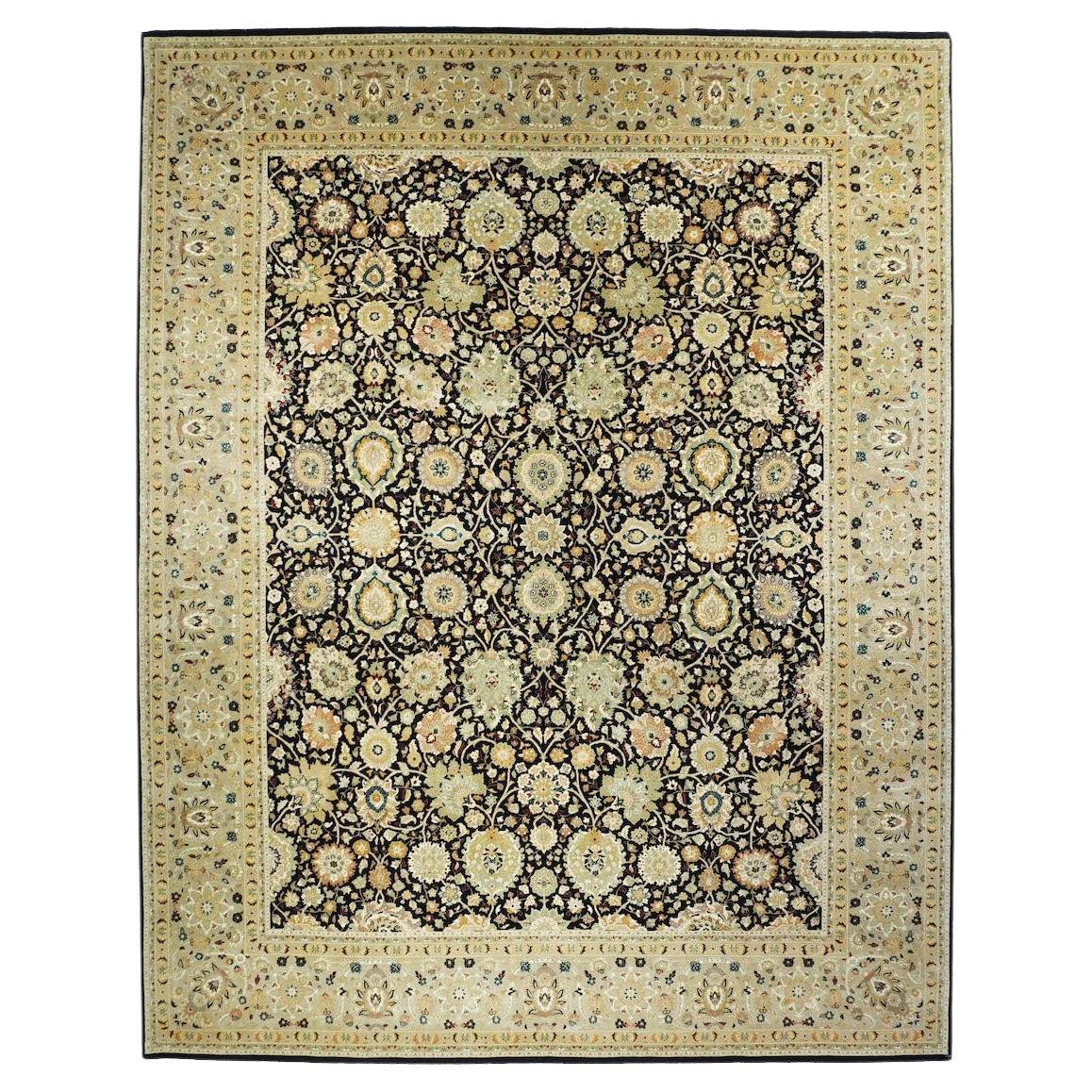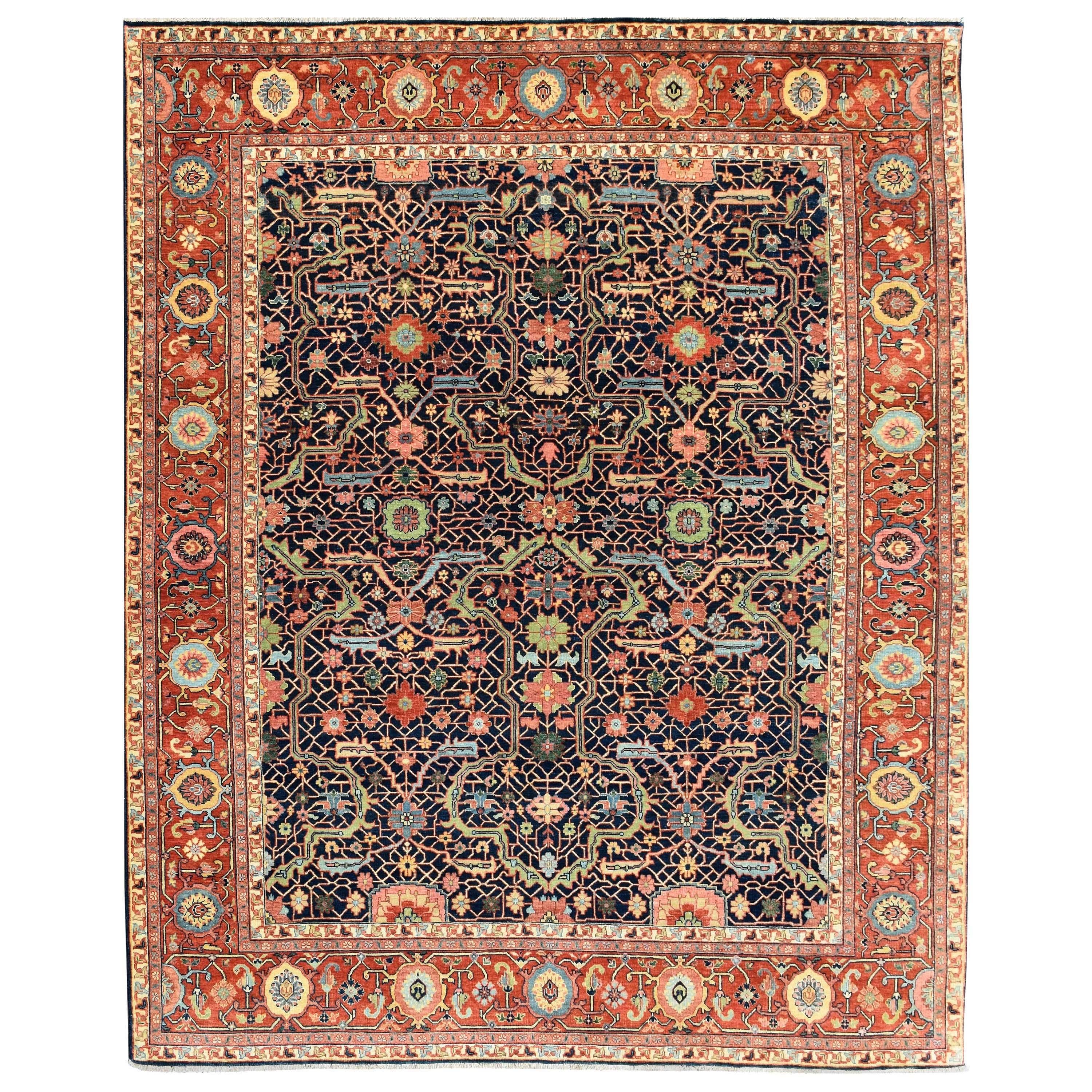Items Similar to Fine Indo Tabriz Persian Design Indian Rug, Hand Knotted
Want more images or videos?
Request additional images or videos from the seller
1 of 11
Fine Indo Tabriz Persian Design Indian Rug, Hand Knotted
About the Item
Fine Indo Tabriz Persian design Indian rug, hand knotted
Design: Floral
Carpets are an integral part of Indian craft traditions. The tradition of carpet weaving in India is centuries old. Carpets are generally made from wool and silk. On the other hand floorings like mats and durries are made up of a variety of material, ranging from wool, cotton, jute, coir, bamboo and grass.
The art of manufacturing carpets was introduced in India, probably by the great mogul Akbar (1556-1605) which brought in Persian weavers together with skilled pattern artists mainly for producing carpets for his palace.
During the 16th, 17th and 18th century many fine carpets were woven here made of the finest sheep wool and silk, with Persian patterns. The quality sank during the 19th century and right up to the middle of the 20th century, except some smaller productions in the cities of Srinagar, Amritsar and Agra.
To tell the origin of an Indo carpet they often use a prefix; Indo Mir, Pakistan-Bochara and Indo Gabbeh which are very different from a Persian Gabbeh for example.
Other carpets from India are sold under the names of Amritsar, Bhadohi, Jaipur, Kashmir, Mirsapur and Srinagar.
- Dimensions:Width: 132 in (335.28 cm)Length: 204 in (518.16 cm)
- Style:Tabriz (In the Style Of)
- Materials and Techniques:Wool,Hand-Knotted
- Place of Origin:
- Period:
- Date of Manufacture:2010
- Production Type:New & Custom(One of a Kind)
- Estimated Production Time:Available Now
- Condition:
- Seller Location:New York, NY
- Reference Number:

About the Seller
4.6
Vetted Seller
These experienced sellers undergo a comprehensive evaluation by our team of in-house experts.
Established in 1916
1stDibs seller since 2019
97 sales on 1stDibs
Typical response time: 1 hour
- ShippingRetrieving quote...Ships From: New York, NY
- Return PolicyA return for this item may be initiated within 7 days of delivery.
More From This SellerView All
- Pakestan Rug Tabriz Design, Hand KnottedLocated in New York, NYPakistan rug Tabriz design, hand knotted Design: Tabriz Color: Black border, beige The art of weaving developed in the region comprising Pakistan at a time when few other civilizations employed it. Excavations at Moenjodaro and Harappa, ancient cities of the Indus valley civilization, have established that the inhabitants used spindles and spun a wide variety of weaving materials. Some historians consider that the Indus Valley civilization first developed the use of woven textiles. Carpet weaving may have been introduced into the area of present-day Pakistan as far back as the eleventh century with the coming of the first Muslim conquerors, the Afghan Ghaznavids and the Ghaurids. It can with more certainty be traced to the beginning of the Mughal Dynasty in the early 16th century, when the last successor of Timur, Babur, extended his rule from Kabul, Afghanistan to Dhaka, Bangladesh and founded the Mughal Empire. Under the patronage of the Mughals, local craftsmen adopted Persian techniques and designs. Carpets woven in the Punjab at that time (often called Lahore carpets today) made use of motifs and decorative styles found in Mughal architecture. Photograph of carpet weavers in Karachi Jail, 1873 During the Mughal period, the carpets made on the South Asia became so famous that demand for them spread abroad. These carpets boasted distinctive designs and high knot densities. Carpets made for the Mughal emperors, including Jahangir and Shah Jahan, were of the finest quality. Under Shah Jahan's reign, Mughal carpet-weaving took on a new aesthetic and entered its classical phase. The carpets woven in Lahore were the first to reach European markets, including England, as far back as 17th century. During the British colonial era, prison weaving was established in district and female jails in cities such as Lahore and Karachi. Carpet-weaving outside of jails was revived after the independence when Pakistan's carpet-weaving industry flourished.[1] At present, hand knotted carpets are made by Afghan refugees residing in Pakistan, making carpets and one of the country's leading export products. Hand knotted rug manufacture is Pakistan's second-largest cottage and small industry. The craftsmen have the capacity to produce any type of carpet using all the popular motifs of guls, medallions, paisleys (botehs), traceries, and geometric designs in various combinations. Pak Persian Persian inspired curvilinear and/or floral designs, usually styled from old Kashan...Category
2010s Pakistani Tabriz Indian Rugs
MaterialsWool
- Fine Pak Persian Tabriz Design Rug, Wool, Hand KnottedLocated in New York, NYFine Pak Persian Tabriz Design rug, wool, hand knotted Design: Floral all-over A Pakistani rug (Pak Persian Rug or Pakistani carpet) is a type of handmade floor-covering textile traditionally made in Pakistan. The art of weaving developed in the region comprising Pakistan at a time when few other civilizations employed it. Excavations at Moenjodaro and Harappa - ancient cities of the Indus Valley civilization - have established that the inhabitants used spindles and spun a wide variety of weaving materials. Some historians consider that the Indus Valley civilization first developed the use of woven textiles. Carpet weaving may have been introduced into the area of present-day Pakistan as far back as the 11th century with the coming of the first Muslim conquerors, the Afghan Ghaznavids and the Ghaurids. It can with more certainty be traced to the beginning of the Mughal Dynasty in the early 16th century, when the last successor of Timur, Babur, extended his rule from Kabul, Afghanistan to Dhaka, Bangladesh and founded the Mughal Empire. Under the patronage of the Mughals, local craftsmen adopted Persian techniques and designs. Carpets woven in the Punjab at that time (often called Lahore carpets today) made use of motifs and decorative styles found in Mughal architecture. Photograph of Carpet Weavers in Karachi Jail - 1873 During the Mughal period, the carpets made on the South Asia became so famous that demand for them spread abroad. These carpets boasted distinctive designs and high knot densities. Carpets made for the Mughal emperors, including Jahangir and Shah Jahan, were of the finest quality. Under Shah Jahan's reign, Mughal carpet-weaving took on a new aesthetic and entered its classical phase. The carpets woven in Lahore were the first to reach European markets, including England, as far back as 17th century. During the British Colonial era, prison weaving was established in district and female jails in cities such as Lahore and Karachi. Carpet-weaving outside of jails was revived after the independence when Pakistan's carpet-weaving industry flourished. At present, hand knotted carpets are made by Afghan refugees residing in Pakistan, making carpets and one of the country's leading export products. Hand knotted rug manufacture is Pakistan's second-largest cottage and small industry. The craftsmen have the capacity to produce any type of carpet using all the popular motifs of guls, medallions, paisleys (botehs), traceries, and geometric designs in various combinations. Pak Persian Persian inspired curvilinear and/or floral designs, usually styled from old Kashan...Category
Vintage 1970s Tabriz Central Asian Rugs
MaterialsWool, Silk
- Extremly Fine Persian Tabriz Benam Rug, Hand Knotted, circa 1970sLocated in New York, NYExtremly fine Persian Tabriz Benam rug, hand knotted, circa 1970s Design: Benam A Tabriz rug/carpet is a type in the general category of Persian carpets from the city of Tabriz...Category
Vintage 1970s Persian Tabriz Persian Rugs
MaterialsWool, Silk
- Pak Tabriz Design Rug 10'0'' x 14'0''Located in New York, NYA Pakistani rug (Pak Persian Rug or Pakistani carpet) is a type of handmade floor-covering textile traditionally made in Pakistan. Pak Persian Persian inspired curvilinear and/or floral designs, usually styled from old Kashan...Category
20th Century Pakistani Indian Rugs
MaterialsWool, Cotton
- Fine Persian Tabriz Area RugLocated in New York, NYFine Persian Tabriz Area RugCategory
20th Century Asian Tabriz Persian Rugs
MaterialsWool, Cotton, Silk
- Fine Persian Tabriz Area RugLocated in New York, NYFine Persian Tabriz Area RugCategory
20th Century Persian Tabriz Persian Rugs
MaterialsWool, Silk
You May Also Like
- PETAG TABRIZ Design Indian Hand-Knotted RugLocated in Lohr, Bavaria, DEA beautiful contemporary rug showing a design of the PETAG company. PETAG - Persische Teppich Aktien Gesellschaft - was a german company that was found in 1911 in Berlin / Germany. P...Category
2010s Indian Persian Rugs
MaterialsWool
- Wonderful New Persian Design Indian Fine RugLocated in Saint Ouen, FRNice new rug with beautiful Persian design and nice colors, entirely hand knotted with wool and silk velvet on cotton foundation.Category
2010s Indian Tabriz Persian Rugs
MaterialsWool
- Wonderful New Persian Design Fine Indian RugLocated in Saint Ouen, FRNice new rug with beautiful Persian design and nice colors, entirely hand knotted with wool and silk velvet on cotton foundation.Category
2010s Indian Tabriz Persian Rugs
MaterialsWool
- Wonderful New Persian Design Indian Fine RugLocated in Saint Ouen, FRNice new rug with beautiful Persian design and nice colors, entirely hand knotted with wool and silk velvet on cotton foundation.Category
2010s Indian Tabriz Persian Rugs
MaterialsWool
- Wonderful New Persian Design Indian Fine RugLocated in Saint Ouen, FRNice new rug with beautiful Persian design and nice colors, entirely hand knotted with wool and silk velvet on cotton foundation.Category
2010s Indian Tabriz Persian Rugs
MaterialsWool
- Wonderful New Persian Design Indian Fine RugLocated in Saint Ouen, FRNice new rug with beautiful Persian design and nice colors, entirely hand knotted with wool and silk velvet on cotton foundation.Category
2010s Indian Tabriz Persian Rugs
MaterialsWool





